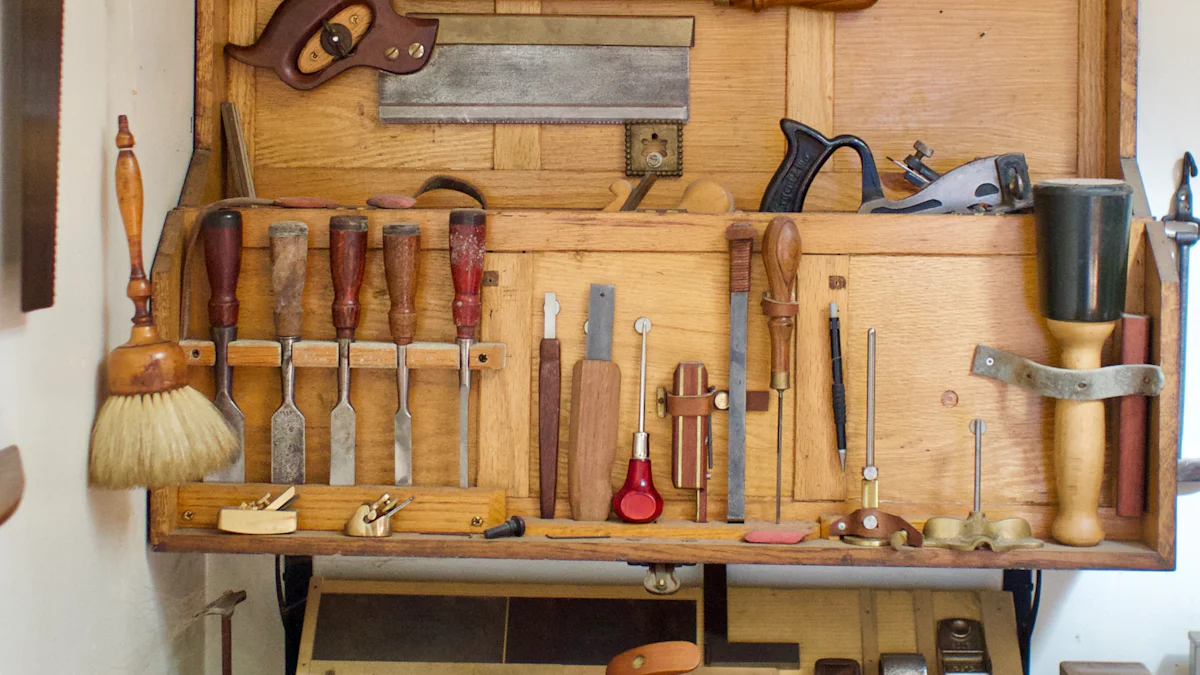
Woodworking hand tools hold great importance in crafting precise and intricate wooden pieces. These tools allow artisans to measure, cut, and shape wood with accuracy. The market for these tools is expected to reach USD 11.41 billion by 2029, reflecting their ongoing relevance.
“Hand tools have evolved from blunt instruments in the Stone Age to sophisticated devices,” notes Paul Sellers, a renowned woodworking expert.
Historically, civilizations have relied on woodworking hand tools for construction and artistry. From ancient times to the Middle Ages, tools like saws, chisels, and planes have played a crucial role. The evolution of these tools has significantly impacted carpentry and building trades.
Essential Woodworking Hand Tools

Must-Have Tools
Saws
Saws are vital in any woodworker’s toolkit. They allow precise cutting of wood into various shapes and sizes. The coping saw excels at curved work, making it indispensable for intricate designs. Carpenters often use saws for both rough cuts and fine detailing.
Chisels
Chisels serve multiple purposes in woodworking. These tools are essential for joinery and refining shapes. The paring chisel is particularly useful for flush-trimming wood plugs and shaving tenon cheeks. Its bent neck design ensures a good grip while working on the piece.
Planes
Planes help shape wood by removing rough surfaces. These tools reduce wood to the correct size for various structures. Main types include block planes, smoothing planes, and jack planes. Each type serves a specific purpose, from initial rough shaping to final smoothing.
Hammers and Mallets
Hammers and mallets are fundamental for driving nails and chisels. These tools provide the force needed for various tasks. Woodworkers use mallets to strike chisels without damaging them. Hammers come in different sizes and weights to suit different applications.
Specialized Tools
Spokeshaves
Spokeshaves are specialized tools for shaping and smoothing wooden rods and shafts. These tools excel at creating rounded edges and intricate curves. Woodworkers often use spokeshaves for chair legs and other rounded components.
Scrapers
Scrapers remove fine shavings and smooth surfaces. These tools are essential for finishing touches. Scrapers can reach areas that sandpaper might miss. They provide a smooth finish without the need for extensive sanding.
Rasps and Files
Rasps and files are crucial for detailed shaping and smoothing. These tools come in various shapes and sizes to suit different tasks. Woodworkers use rasps for rough shaping and files for finer detailing. Both tools help achieve precise and intricate designs.
Best Practices for Using Woodworking Hand Tools
Safety Tips
Proper Handling
Proper handling of woodworking hand tools ensures safety and efficiency. Always grip tools firmly to maintain control. Use both hands when necessary to stabilize the tool. Keep fingers away from cutting edges to prevent injuries. Maintain a clean workspace to avoid accidents.
Protective Gear
Wearing protective gear is crucial when working with woodworking hand tools. Safety goggles protect eyes from flying debris. Gloves provide a better grip and protect hands from cuts. Ear protection is essential when using loud tools. A dust mask prevents inhalation of harmful particles.
Maintenance and Care
Cleaning Tools
Regular cleaning keeps woodworking hand tools in good condition. Remove sawdust and debris after each use. Wipe metal parts with a cloth to prevent rust. Use a brush to clean hard-to-reach areas. Clean tools ensure precise work and longevity.
Sharpening Blades
Sharpening blades is vital for effective use of woodworking hand tools. Dull blades can cause accidents and reduce efficiency. Use a sharpening stone or file to maintain a sharp edge. Follow the manufacturer’s instructions for best results. Regular sharpening ensures clean cuts and smooth finishes.
Storing Tools
Proper storage extends the life of woodworking hand tools. Store tools in a dry place to prevent rust. Use toolboxes or racks to keep tools organized. Hanging tools on a pegboard provides easy access. Proper storage maintains tool quality and readiness.
Inspection Routines
Checking for Damage
Inspect woodworking hand tools regularly for damage. Look for cracks, chips, or wear on handles and blades. Replace damaged parts immediately to avoid accidents. Regular inspection ensures tools remain safe and functional.
Ensuring Sharpness
Ensure the sharpness of woodworking hand tools before each use. Test blades on scrap wood to check for dullness. Sharpen or replace dull blades as needed. Sharp tools provide better control and cleaner cuts. Regular checks maintain tool performance and safety.
“Working wood with hand tools can be a source of pleasure, putting the emphasis on the process as much as on the result,” notes expert woodworkers. Hand tools are essential to the highest level of craftsmanship, bringing a refinement to work that machines alone cannot produce.
Beginner Tips

Developing Foundational Skills
Basic Cutting Techniques
Mastering basic cutting techniques forms the foundation of woodworking. Start with a saw to make straight cuts. Hold the saw firmly and guide it along the marked line. Practice on scrap wood to gain confidence. Use a chisel for more detailed cuts. Position the chisel at the desired angle and tap it gently with a mallet. Repeat this process until achieving the desired depth.
Simple Joinery
Simple joinery techniques enhance the ability to create sturdy structures. Begin with a butt joint, which involves joining two pieces of wood end-to-end. Apply wood glue to the ends and clamp them together until dry. For a stronger bond, use a dowel joint. Drill holes in both pieces and insert dowels coated with glue. Align the pieces and clamp them until the glue sets.
Common Mistakes to Avoid
Overworking the Wood
Overworking the wood can lead to mistakes and wasted material. Avoid excessive sanding, which can thin the wood too much. Use woodworking hand tools like planes and scrapers to achieve a smooth finish without overworking the surface. Always measure twice and cut once to minimize errors.
Using the Wrong Tool
Using the wrong tool can damage the project and the tools. Select the appropriate woodworking hand tools for each task. For example, use a spokeshave for shaping rounded edges and a rasp for rough shaping. Refer to tool guides or seek advice from experienced woodworkers to ensure the correct tool usage.
“Gaining comfort with the basics of plane, saw, and chisel use means that you can build anything without the need for additional tools,” notes an expert woodworker. Learning these fundamental skills will make anyone a better woodworker.
Advanced Tips and Techniques
Mastering Complex Joinery
Dovetail Joints
Dovetail joints create strong connections between pieces of wood. These joints feature interlocking pins and tails, providing both strength and aesthetic appeal. Woodworkers often use dovetail joints for drawers and boxes. Precision in cutting and fitting ensures a tight, durable joint. Mastery of this technique enhances the overall quality of woodworking projects.
Mortise and Tenon
Mortise and tenon joints offer another robust method for joining wood. This technique involves inserting a tenon into a mortise hole, creating a secure bond. Furniture makers frequently use mortise and tenon joints for frames and legs. Accurate measurements and clean cuts are crucial for a snug fit. Practicing this joinery method improves structural integrity and craftsmanship.
Enhancing Precision
Using Jigs
Jigs assist in achieving precise cuts and consistent results. These tools guide saws and chisels, ensuring accuracy. Woodworkers can create custom jigs for specific tasks or purchase ready-made options. Using jigs reduces errors and saves time. Incorporating jigs into the workflow enhances the precision of woodworking hand tools.
Fine-Tuning Cuts
Fine-tuning cuts involves making small adjustments for a perfect fit. Woodworking hand tools like chisels and planes help achieve this level of detail. Careful shaving and trimming ensure components align correctly. Attention to fine-tuning improves the overall finish and functionality of the project. Consistent practice with these techniques leads to superior craftsmanship.
Future Trends in Woodworking Hand Tools
Innovations in Tool Design
Innovations in tool design continue to shape the woodworking industry. Manufacturers focus on improving ergonomics and efficiency. New materials and technologies enhance the performance of woodworking hand tools. These advancements make tools more user-friendly and effective. Staying updated with the latest innovations benefits both novice and experienced woodworkers.
Sustainable Materials
The use of sustainable materials in woodworking hand tools is gaining traction. Eco-friendly options reduce environmental impact. Tools made from recycled or renewable resources promote sustainability. Woodworkers can contribute to conservation efforts by choosing sustainable tools. This trend aligns with the growing emphasis on environmental responsibility in woodworking.
Woodworking hand tools offer precision and craftsmanship. Key points include the importance of essential tools, safety practices, and maintenance routines. Practicing foundational skills and avoiding common mistakes enhance woodworking abilities.
“Woodworking well by hand has nothing to do with having the best setup,” states an experienced woodworker.
Experimentation and practice build confidence and skill. The evolving nature of hand tools, with innovations and sustainable materials, continues to inspire artisans. Embrace the journey of mastering woodworking hand tools for rewarding and creative experiences.
See Also
Complete Manual for Warm Winter with Soft Cozy Socks
Discovering the Range of Socks for Males and Females
